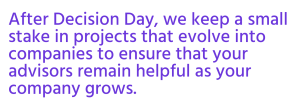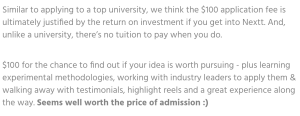Yesterday, a little birdie told me about Nextt, an accelerator (probably more accurately referred to as an incubator) for early-idea-stage startups. The idea is to take a napkin-stage idea and turn it into an MVP of sorts in six weeks. Not a shabby idea, but the insidious thing here is that Nextt charges $100 per idea. Not to participate, mind you — to put in an application.
Ideas are cheap

The Nextt website seems awfully cheerful. Calm down, chap, you’ll wear yourself out.
Starting a startup is hard. It’s daunting. And especially if you haven’t been through the mill a few times, it’s really difficult to know where to even start. Of course, it all begins with the spark of an idea, but if you’ve ever been in a room full of entrepreneurs, you’ll know that any moderately smart person can churn out 50 problems worth solving and 15 viable business ideas before breakfast.
What I’m trying to say is that ideas are cheap. Or rather, they used to be, until Nextt got their paws on them.
Apparently aimed at first-time entrepreneurs and people dipping their toes in entrepreneurial endeavors for the first time, Nextt’s website comes across as a pitch-deck factory.
The outcome of the program, they write, will leave participants with “a sleek highlight reel,” an “opportunity to connect with VCs” and some “testimonials from your project advisors.”
“Our advisor community is made up of designers, data scientists, developers and attorneys,” says the founder of the Nextt accelerator, Ajay Rajani. “These advisors analyze data, write code, design mockups and dedicate many hours to the program in order to provide potential entrepreneurs the opportunity to validate their idea in a cost-effective way.”
“A fair and more accessible way to finance our program”
I don’t want to be disparaging of the deliverables of the program. Undoubtedly, all of those things are of great value to a startup. My issue is that it seems iffy. The startup world is meant to be a place where experienced entrepreneurs are taking care of the newcomers, not exploiting them in the process.
If you’re one of the 87 percent of founders who don’t make the cut, it’s hard to argue you received great value for your money.
“[The $100 application fee] signals that the applicant is serious about their idea [and] makes a commitment to their idea and our expert team and advisor community,” says Rajani. “We see an application fee as a fair and more accessible way to finance our program, and the implicit value of our program is objectively and exponentially more.”
Nextt’s founder tells me that the company received 21 applications for its first invite-only cohort, before accepting four (19 percent) of the companies. For its second cohort, it received 42 applications and accepted another four (10.5 percent). It is currently trying to recruit an additional 5-15 successful applicants for a September cohort.
But… Nextt can see the idea even if you don’t pay
A troubling aspect of this is that the application form is a three-step process in the shape of a Typeform form. When I first heard of the program, my first port of call was to have a closer look at the sort of questions the accelerator asks its participants. I clicked on the Submit an Idea link in the menu, then the Jump to Form button.
On the first page, I agreed that Nextt won’t sign an NDA. On the second page, I filled in all the details about my idea, the problem it solves and a competitor analysis. On the third page, I was surprised by a payment form.

This is the screen that meets you after you’ve already filled in all the details about your idea.
I agree that perhaps I should read more carefully than I did before pitching my next drone startup, but it’s worrying there are several ways through the website (including the one I took) where you won’t see a warning that this is a paid-for application until you hit the payment part of the application form. You’ve already agreed to not signing an NDA, but the data from page two — where you share the idea of your startup — is saved. If you at that point decide to not pay, Nextt still has access to your idea.

Nextt keeps “a small stake” in projects that work out, but I couldn’t find anywhere on its website what that means. The most obvious place to go looking — the company’s terms and conditions — doesn’t appear to exist.
If you’re panicking, wondering what is happening to your idea at that point, it is not particularly reassuring to discover that the company’s terms and conditions link doesn’t work; it simply points to the site’s home page.
As I mentioned in the beginning of this article, ideas are cheap, so Nextt having access to a startup’s ideas isn’t necessarily a big deal… But the problem is that doesn’t matter, because the target audience — very new entrepreneurs — don’t know that; they think their idea is worth its weight in printer ink. Which I think means that they are far more likely than most to reach for their wallets to cough up the $100.
“Typeform by default collects data from all form participants, including those who do not fully complete the application process,” says Rajani. He claims that Nextt “does not review the application in depth” until a fee has been collected.

“Justified by the return on investment if you get into Nextt” — but no word on what happens if you don’t.
On the site, Nextt points out that it chooses to charge an application fee to ensure the founders’ commitment. The company claims it’s cheap and that it’s totally worth it, if you are accepted into the program.
I completely agree — if Nextt delivers on everything it promises, $100 is a bona fide bargain, but only if you’re selected to participate. If you’re one of the 87 percent of founders who don’t make the cut, it’s hard to argue you received great value for your money.
“Should an idea not be accepted, Nextt provides the applicant with a summary of their idea’s strengths and weaknesses,” Rajani explained to me, clarifying the accelerator’s position on the matter. The accelerator also offers feedback and suggestions on what an applicant could try next.
Some sort of pay-to-enter competition?
Charging someone to apply for an accelerator — not to participate, just to apply — feels really exploitative. I have no problem with companies offering a service and then charging for it. That’s how businesses are supposed to work. Charging for a possibility of being able to work with an accelerator is daft.
“The $100 application fee is clearly disclosed on the apply page and we have not yet received a single complaint from applicants,” Rajani says.
My feeling is that at this point, you may as well just call it a pay-to-enter competition. If we do, there’s a problem, too: By not posting terms and conditions or proper contact information, Nextt’s site doesn’t appear to comply with the laws for operating these kinds of competitions.
So, what’s the solution?
The question is whether inexperienced would-be startup founders would be willing to pay $100 to enter a competition for someone to tell them whether or not their idea has merit. If the choice is between spending $100 on a 13 percent chance of getting some help, or spending the same amount of money on this 13-book reading list, for example, I know what my choice would be.
From the numbers the founder gave me, it looks like Nextt has had 63 applications to date, and accepted eight of them. That’s about $790 per idea — maybe a more honest way of doing this would be to make applications free and charge the startups $800 if they are selected to participate. It would certainly feel a lot less exploitative.
Accelerators: Don’t charge for applications. You’re better than that.
After this post was published, Rajani wrote a reply on LinkedIn.